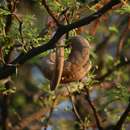en
names in breadcrumbs


Acacia erioloba, known as Giraffe Thorn or as Camel Thorn (a mistranslation from the Afrikaans name “Kameeldoring”, meaning Giraffe Thorn) is an African species in the large and taxonomically controversial Acacia genus.It is the dominant tree, highly recognizable, on the Kalahari plains in Angola, Botswana, Mozambique, Namibia, South Africa, Zambia, and Zimbabwe, often growing in and along the banks of riverbeds.
Camel Thorn trees grow up to 18 m tall, with a large spreading canopy that produces shade and animal shelter.Trees older than 10 years produce numerous yellow ball-shaped inflorescences, and trees older than 20 years produce crops of up to 1,200 flat, crescent-shaped seedpods per tree.Studies suggest that trees may live 250-300 years.Large herbivores, including black rhinos, elephants, giraffes, gemsbok, elands and kudus are agents of seed dispersal as they eat large numbers of pods, passing the seeds with their tough seed coats through their gut intact and then providing excellent germination conditions in the dung they expel with the seed.The trunk of A. erioloba, like many Acacia species, is covered with paired thorns about 2-5 cm long.The base of older thorns frequently houses ant galls up to 2 cm across used as protection by a large invertebrate fauna.The tap root can grow up to 60 m, allowing this tree to access deep ground water sources.
Acacia erioloba is considered a keystone species, with many other species and ecosystem parameters dependent on it.At the same time, this tree provides valuable resources to people: dark, hard, insect-resistant wood for lumber, also considered excellent for fuel and cooking purposes; abundant, nutritious pods sometimes used to make a hot coffee-like drink or porridge, and as highly nutritional fodder for cattle (although leaves and pods produce prussic acid in quantities that poison livestock at some times of the year); edible and medicinal gum and bark. Although it is a hardy species, frost and drought resistant, A. erioloba is slow-growing, slow to propagate and of most value as a large established tree.The large trees, however, are vulnerable; they are regularly cleared for agricultural and grazing development as well as harvested for lumber and for what is considered high quality charcoal and firewood. This species has protected status in South Africa.
(Arid Zone Trees 2003-2013; Orwa et al. 2009; Seymore and Milton 2003)
Vachellia erioloba, the camel thorn, also known as the giraffe thorn, mokala tree, or Kameeldoring in Afrikaans, still more commonly known as Acacia erioloba, is a tree of southern Africa in the family Fabaceae.[2] Its preferred habitat is the deep dry sandy soils in parts of South Africa, Botswana, the western areas of Zimbabwe and Namibia. It is also native to Angola, south-west Mozambique, Zambia and Eswatini.[3] The tree was first described by Ernst Heinrich Friedrich Meyer and Johann Franz Drège in 1836.[3] The camel thorn is a protected tree in South Africa.[4]
The tree can grow up to 20 metres high. It is slow-growing, very hardy to drought and fairly frost-resistant. The light-grey colored thorns reflect sunlight, and the bipinnate leaves close when it is hot.[5] The wood is dark reddish-brown in colour and extremely dense and strong. It is good for fires, which leads to widespread clearing of dead trees and the felling of healthy trees. It produces ear-shaped pods, favoured by many herbivores including cattle. The seeds can be roasted and used as a substitute for coffee beans.[6]
The name 'camel thorn' refers to the fact that giraffe (kameelperd in Afrikaans) commonly feed on the leaves with their specially-adapted tongue and lips that can avoid the thorns. The scientific name 'erioloba' means "wooly lobe", a reference to the ear-shaped pods.[7]
It is commonly associated with the long running PBS wildlife program Nature, as the tree is used in the title sequence and program logo.[8]
Vachellia erioloba hosting a nest of sociable weavers (Philetairus socius).
Vachellia erioloba seeds, lying upon the ground, scattered among their pods, Sossusvlei, Namib Desert, Namibia
The sharp thorns of the Mokala resemble barbed wire (growing near Potgietersrust in Limpopo, South Africa)
Vachellia erioloba - Museum specimen - MHNT
Camel thorn scattered on dunes in the Kalahari Desert in Namibia (2017)
Vachellia erioloba, the camel thorn, also known as the giraffe thorn, mokala tree, or Kameeldoring in Afrikaans, still more commonly known as Acacia erioloba, is a tree of southern Africa in the family Fabaceae. Its preferred habitat is the deep dry sandy soils in parts of South Africa, Botswana, the western areas of Zimbabwe and Namibia. It is also native to Angola, south-west Mozambique, Zambia and Eswatini. The tree was first described by Ernst Heinrich Friedrich Meyer and Johann Franz Drège in 1836. The camel thorn is a protected tree in South Africa.
The tree can grow up to 20 metres high. It is slow-growing, very hardy to drought and fairly frost-resistant. The light-grey colored thorns reflect sunlight, and the bipinnate leaves close when it is hot. The wood is dark reddish-brown in colour and extremely dense and strong. It is good for fires, which leads to widespread clearing of dead trees and the felling of healthy trees. It produces ear-shaped pods, favoured by many herbivores including cattle. The seeds can be roasted and used as a substitute for coffee beans.
The name 'camel thorn' refers to the fact that giraffe (kameelperd in Afrikaans) commonly feed on the leaves with their specially-adapted tongue and lips that can avoid the thorns. The scientific name 'erioloba' means "wooly lobe", a reference to the ear-shaped pods.
It is commonly associated with the long running PBS wildlife program Nature, as the tree is used in the title sequence and program logo.